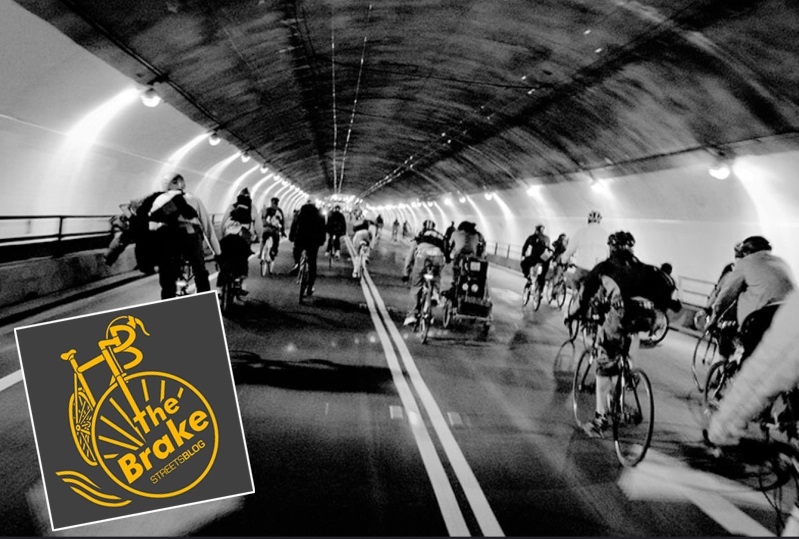Neighborhood walking tours, group bike rides, and organized strolls in the park aren't typically thought of as front-line strategies to break a city's dependence on automobiles. Some advocates argue that without events like them, though, U.S. neighborhoods will never transform into truly people-centered places — particularly in socially and racially marginalized communities.
On this episode of The Brake, host Kea Wilson sits down with Olatunji Oboi Reed, president and CEO of Equiticity, to talk about what he and his colleagues call "community mobility rituals," or regularly-scheduled, free, hyper-local events that dismantle barriers to sustainable transportation and build the social infrastructure that neighborhoods need. Along the way, we chat about what makes a "mobility ritual" different than your standard-issue Critical Mass ride, why white-dominated transportation authorities tend to overlook the power of these community programs, and how mobility rituals might be integrated into the planning process itself.
Listen in, check out an excerpt from our conversation, and watch the first in Equiticity's webinar series on community mobility rituals below — and don't forget to subscribe on Apple Podcasts, or anywhere else you listen.
The following excerpt has been edited for clarity and length.
Kea Wilson: One of the criticisms I've heard of more traditional group bike rides like Critical Mass — and you can tell me if those qualify as community mobility rituals — is that they're temporary; people reclaim the streets for a little while, but then then the bikes roll through and they're gone. What do you say to folks who have that sort of critique?
Oboi Reed: Yeah, it's a valid critique. And I should say this, at the outset of answering this question: I love Critical Mass. Critical Mass, and an organization called Red, White and Green, which was born in Oakland and still chapter in Oakland is now chapter in Atlanta. Those two organizations helped me get comfortable riding bikes on the street.
However, what makes Critical Mass temporary is not the frequency. It's the people. One difference between Critical Mass and our community mobility rituals is that with Critical Mass, often you have thousands of people coming to a neighborhood who do not live there.
For our community mobility rituals, our target audience is always people who live in the neighborhood in which that ritual is happening. It doesn't mean others are not welcome. It means that we are strategic around questions like, how do we assure Black and brown people at the neighborhood level are comfortable participating, and feel a sense of ownership over the ritual? That's why having community partners is so critical. That's why working with those community partners for the marketing, for the ideation, for the themes for the stops, for the narrator — all of that is critical to ensuring that people at the neighborhood level are the ones who are participating and enjoying the ritual...
What we have to avoid is rituals where the primary audience doesn't live in a neighborhood and doesn't feel a sense of connection to a neighborhood, [or even] a sense of responsibility to our neighborhoods. Our approach, we believe, helps us show that we don't have that challenge.
Wilson: I'm wondering if you could talk a little bit about how the community mobility ritual model might be used in more traditional transportation planning processes. Is this something we can do before putting in bike lanes, before we widen sidewalks, before we redesign transportation networks — and if so, why aren't we already doing it?
Reed: I think part of the starting point for this question is an acknowledgement that transportation in our country has harmed Black, Brown and indigenous people. And what is it about our approach to executing against transportation that is so harmful? Part of it is, as I mentioned earlier, this sort of academic clinical approach that lacks creativity and culture.
The idea that there's a way to infuse culture and history into a transportation project is so foreign to the mainstream transportation industry sector. But the truth is, when culture is infused into the process, Black and brown people in particular will feel a deeper connection to it. And when the approach is to just plop a bike lane down in a neighborhood, with little community ownership and little culture and history infused [into that process] — it literally contributes to the resistance against the bikeway.
Now consider an approach where the DOT goes into a neighborhood and says to these critically important vibrant black or brown organizations, 'here's $150,000. We're going to provide our technical expertise are going to share some parameters that you have to think about, and together, we're going to explore how to create some bike infrastructure that helps more people riding in a more cohesive way, [in such a way that the] needs of your neighborhood are responded to in this infrastructure, in a way that is cultural and reflects the history of your neighborhood.' That is an approach that is a tectonic shift away from how our industry operates. And that is an approach that I am much more confident will generate support for bike infrastructure.
These things shouldn't be optional. Culture and history and style and all of this creativity, it shouldn't be optional. It should be required. And the reason it's not required just because that commitment requires work. It requires finances. It requires a new way of operating. And these DOTs and MPOs are entrenched, and they really believe theirs is the only way to execute in our society. And that's just not something that we accept.







